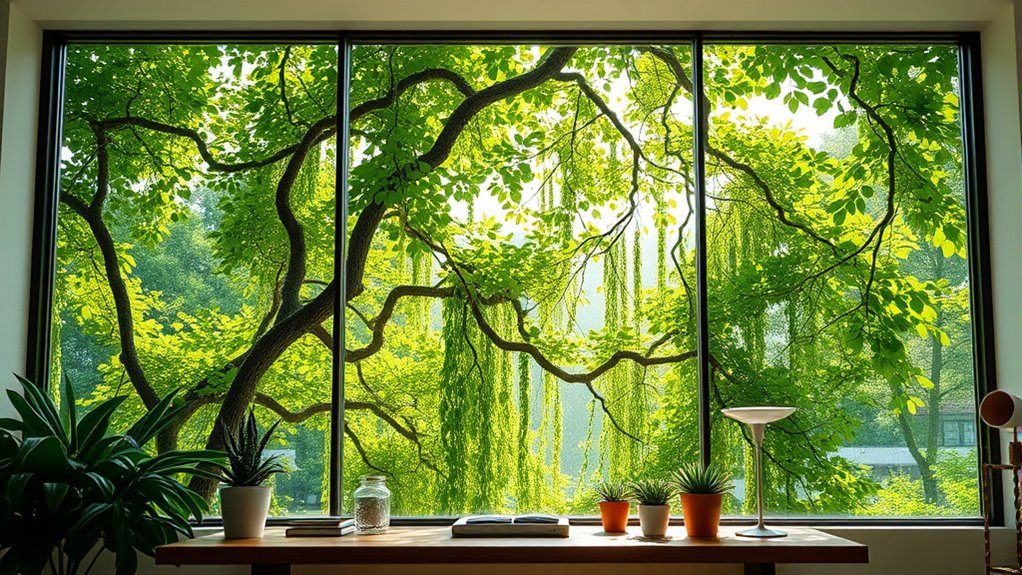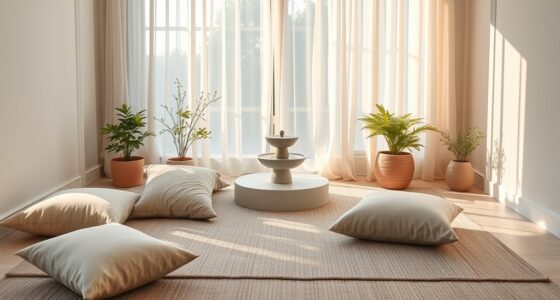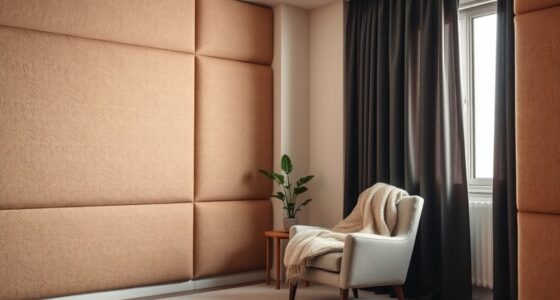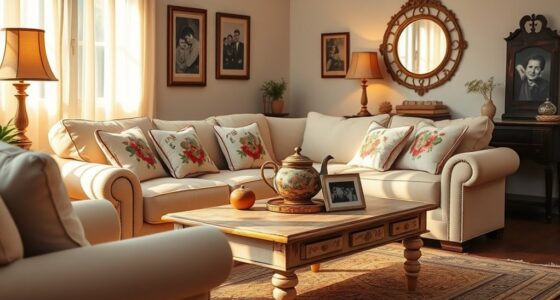A view of trees in your environment activates natural response mechanisms that help reduce stress and promote calmness in your brain. Natural elements like greenery and sunlight boost your mood, improve focus, and create a soothing atmosphere. When you can see trees, your body lowers cortisol levels and relaxes more easily. This connection to nature helps foster mental health and relaxation, making your space feel more comforting. Keep exploring to discover how biophilic design can transform your surroundings.
Key Takeaways
- Viewing trees provides a natural visual connection that triggers relaxation and reduces stress responses.
- Natural scenes like trees help regulate cortisol levels, promoting mental calmness.
- The presence of greenery stimulates the parasympathetic nervous system, enhancing relaxation.
- Trees in view mimic natural environments, decreasing feelings of confinement and overstimulation.
- Exposure to natural views supports mental restoration, improving focus and emotional well-being.
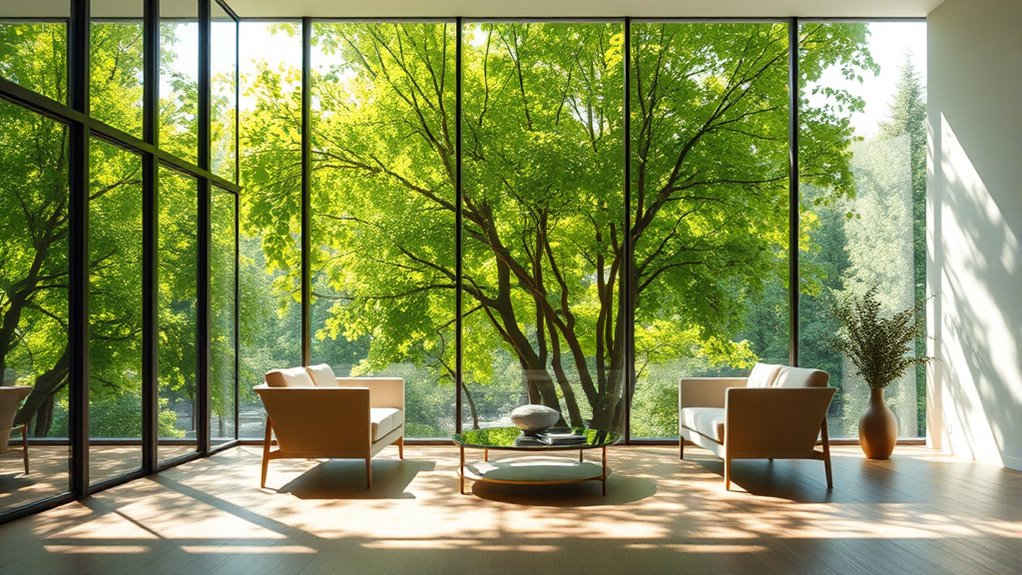
Biophilic design integrates natural elements into built environments to create spaces that connect people with nature. When you incorporate features like natural light and indoor plants, you’re not just beautifying a room—you’re actively influencing your mental well-being. Natural light plays a crucial role in this design approach, as it helps regulate your circadian rhythm, boosts mood, and increases productivity. Large windows, skylights, or glass walls allow sunlight to flood your space, making it feel more open and inviting. As sunlight filters in, it signals your brain that it’s daytime, which can reduce feelings of fatigue and improve focus. The warmth and brightness of natural light also lift your spirits, helping you feel more energized and less stressed. The use of high contrast ratios in lighting design can further enhance the visual clarity and comfort of these spaces. Indoor plants are another key element in biophilic design that fosters a calming environment. When you add greenery into your space, you’re not just bringing in a splash of color; you’re creating a living connection to nature that can greatly lower stress levels. Plants like pothos, snake plants, or peace lilies are easy to care for and thrive indoors, making them practical choices for homes and offices alike. As you care for these plants, your mind receives a gentle reminder of growth and vitality, which can be grounding during busy or stressful days. Plus, indoor plants improve air quality by filtering pollutants, which helps you breathe easier and feel more alert. Their presence also adds a sense of tranquility, softening harsh lines and creating a more welcoming environment. When natural light and indoor plants work together, they amplify each other’s calming effects. Bright, sunlit rooms filled with lush greenery tend to feel more spacious and alive, encouraging relaxation and mental clarity. This combination mirrors the natural environments your brain is wired to seek out, reducing feelings of confinement or overstimulation. You might notice that spending time in such spaces makes you feel more centered and less anxious. The visual connection to nature—even through a simple view of trees outside your window—can trigger a relaxation response in your brain, lowering cortisol levels and easing tension. So, by intentionally designing with large windows for ample natural light and incorporating indoor plants, you create a sanctuary that not only looks appealing but also nurtures your mental health.
Frequently Asked Questions
How Does Biophilic Design Improve Mental Health?
You might wonder how your environment affects your mental health. When you foster a nature connection through biophilic design, you actively engage your senses with natural elements like plants and views of trees. This sensory engagement reduces stress, boosts mood, and enhances focus. By surrounding yourself with nature-inspired features, you create a calming space that supports mental well-being and helps you feel more relaxed and centered throughout your day.
Can Biophilic Design Reduce Workplace Stress Effectively?
You can see that biophilic design effectively reduces workplace stress by incorporating natural elements like natural light and indoor plants. These features help you feel more relaxed, improve your mood, and lower anxiety levels. When you have access to natural light and greenery, your brain releases calming chemicals, making stressful moments easier to handle. So, designing your workspace with these elements isn’t just aesthetic—it’s a smart way to boost your well-being.
What Specific Types of Trees or Greenery Are Most Calming?
You’re wondering which trees or greenery are most calming. Evergreen trees, with their constant greenery, provide a soothing, stable presence that reduces stress. Flowering plants add vibrant color and natural beauty, enhancing relaxation. Both types promote tranquility by connecting you with nature’s rhythms. Incorporating these into your environment can create a calming atmosphere, helping you feel more centered and less anxious throughout your day.
Is Biophilic Design Suitable for Urban Apartment Spaces?
You can definitely bring biophilic design into your urban apartment, transforming it into an oasis. Creating balcony gardens or incorporating indoor greenery helps craft your own urban jungle, making your space more calming and inviting. Adding plants with calming foliage, like ferns or snake plants, enhances tranquility. Even small touches, like window planters or vertical gardens, make a big difference, reconnecting you with nature amid city life.
How Quickly Can One Experience the Calming Effects of Greenery?
Imagine stepping into a peaceful garden; instantly, you feel a gentle breeze and hear birdsong. This allegory shows how greenery can trigger an instant relaxation and a positive sensory response. You might notice calming effects within seconds of seeing trees or plants, as your brain reacts to natural sights. The calming benefits are quick, making greenery a powerful tool for reducing stress and promoting mental clarity almost immediately.
Conclusion
Embracing biophilic design means more than just pretty views; it’s about nurturing your well-being. When you surround yourself with nature’s calming presence, you’re tapping into a natural remedy that keeps stress at bay. Don’t wait until it’s too late—remember, a picture is worth a thousand words, and a view of trees offers a thousand reasons to feel more at peace. Let nature be your sanctuary and watch your mind bloom.
